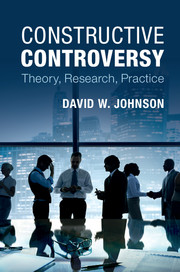Book contents
- Frontmatter
- Contents
- List of figures
- List of tables
- Acknowledgments
- 1 Underlying foundations of constructive controversy
- 2 The nature of constructive controversy
- 3 Theory of constructive controversy
- 4 The processes of constructive controversy and concurrence seeking
- 5 The outcomes of constructive controversy
- 6 Conditions mediating the effects of constructive controversy
- 7 Constructive controversy and decision making
- 8 Constructive controversy in education
- 9 Constructive controversy and political discourse in democracies
- 10 Constructive controversy, creativity, and innovation
- 11 Constructive controversy and building and maintaining peace
- 12 Conclusions
- References
- Index
10 - Constructive controversy, creativity, and innovation
Published online by Cambridge University Press: 05 June 2015
- Frontmatter
- Contents
- List of figures
- List of tables
- Acknowledgments
- 1 Underlying foundations of constructive controversy
- 2 The nature of constructive controversy
- 3 Theory of constructive controversy
- 4 The processes of constructive controversy and concurrence seeking
- 5 The outcomes of constructive controversy
- 6 Conditions mediating the effects of constructive controversy
- 7 Constructive controversy and decision making
- 8 Constructive controversy in education
- 9 Constructive controversy and political discourse in democracies
- 10 Constructive controversy, creativity, and innovation
- 11 Constructive controversy and building and maintaining peace
- 12 Conclusions
- References
- Index
Summary
INTRODUCTION
Many countries around the world are becoming more diverse. There are a few countries, such as the United States, Canada, and, more recently, Australia, that have encouraged the emigration of diverse populations and pride themselves for their diverse citizenry. Imagine yourself as part of a committee of government officials who are trying to decide whether diversity of emigration should be encouraged or discouraged. To ensure that both sides get a complete and fair hearing, you have divided your committee into two groups to present the best case possible for each side of the issue. You assign Group A the position that diversity is a resource that has many beneficial influences. You assign Group B the position that diversity is a problem that has many harmful influences. The overall goal is for the entire committee to write a report giving their best reasoned judgment about what the emigration policy should be regarding diversity. Ideally, all members will agree. The steps of constructive controversy are then followed to ensure that the resulting interaction will enhance creative problem solving.
“We should encourage the emigration of diverse populations to our country,” stated a member of Group A. “Not only will it increase our productivity as a country, but it will decrease the stereotyping and prejudice in our country and result in positive relationships. Opposites attract, you know.”
“Nonsense,” said a member of Group B. “We have to stop any emigration of diverse populations to our country. Not only will it decrease our productivity by causing so many interpersonal problems on the job, it will increase anxiety and tension and strain in interacting with store clerks, colleagues, and neighbors. Forced friendliness actually is not easy. That strain cannot be good for people. Since people tend to like people they think are similar to themselves, there is going to be a lot of negativity and dislike among citizens. Stereotyping and prejudice is bound to get worse.”
- Type
- Chapter
- Information
- Constructive ControversyTheory, Research, Practice, pp. 165 - 179Publisher: Cambridge University PressPrint publication year: 2015



